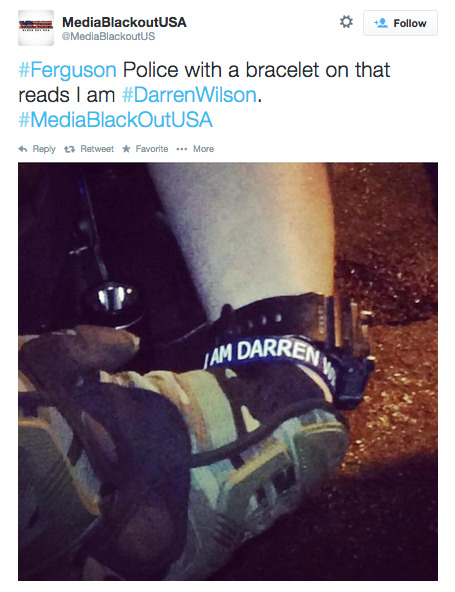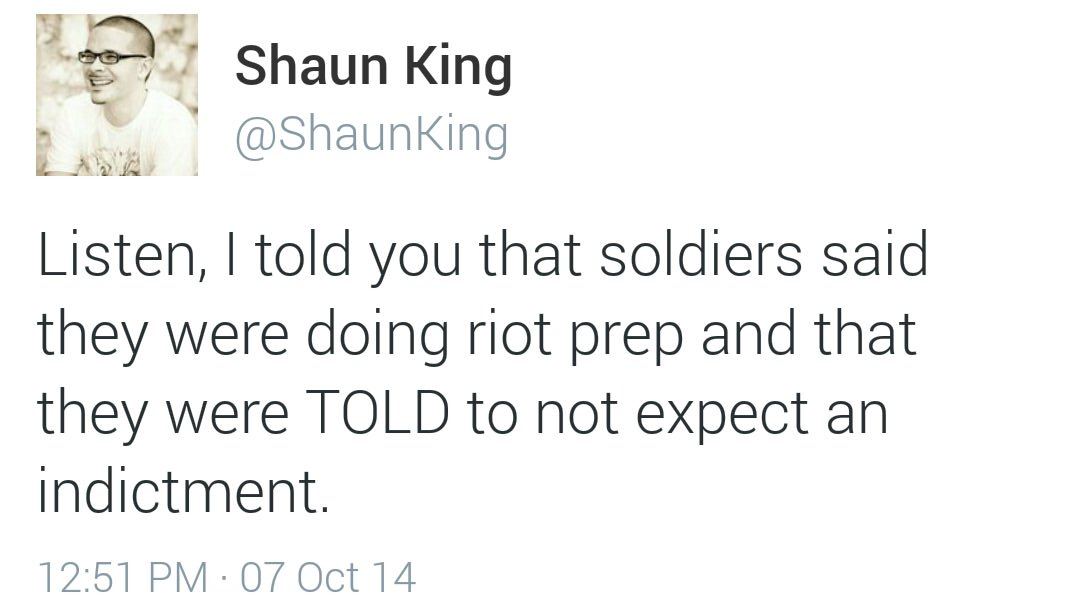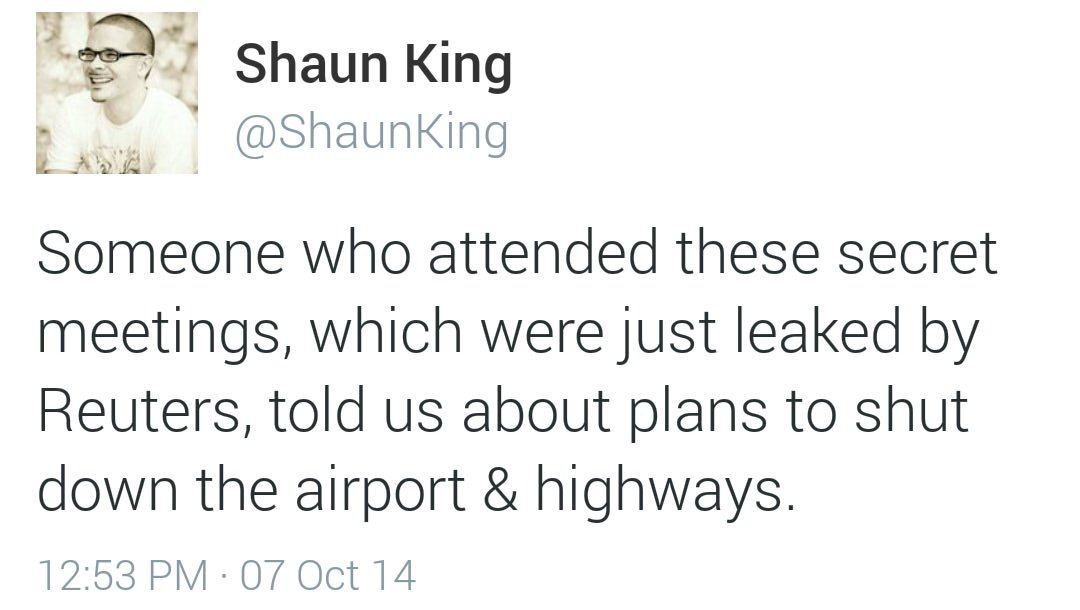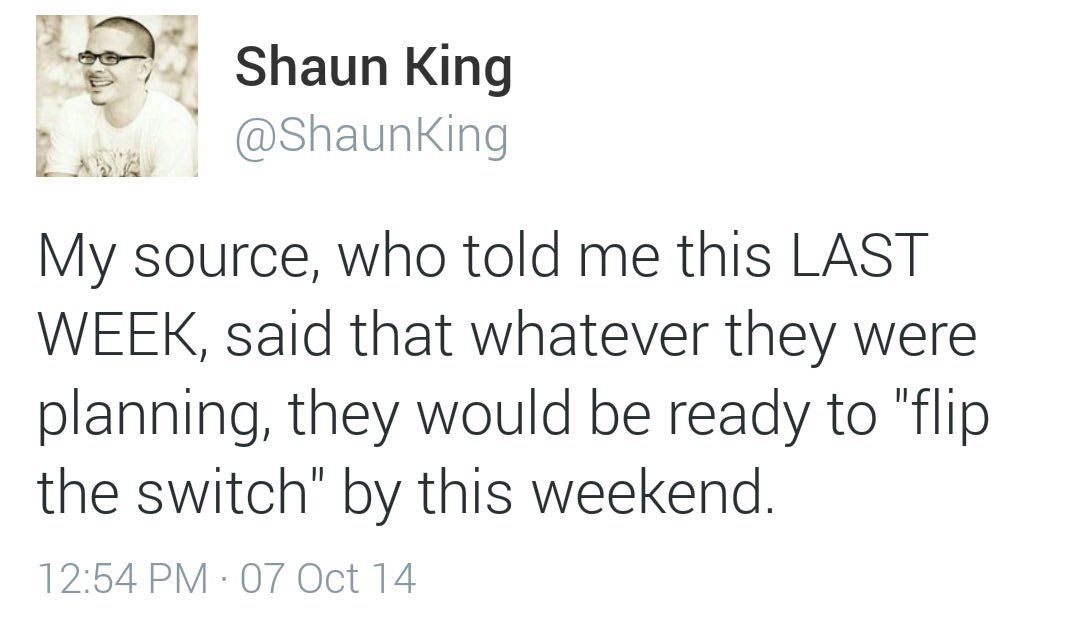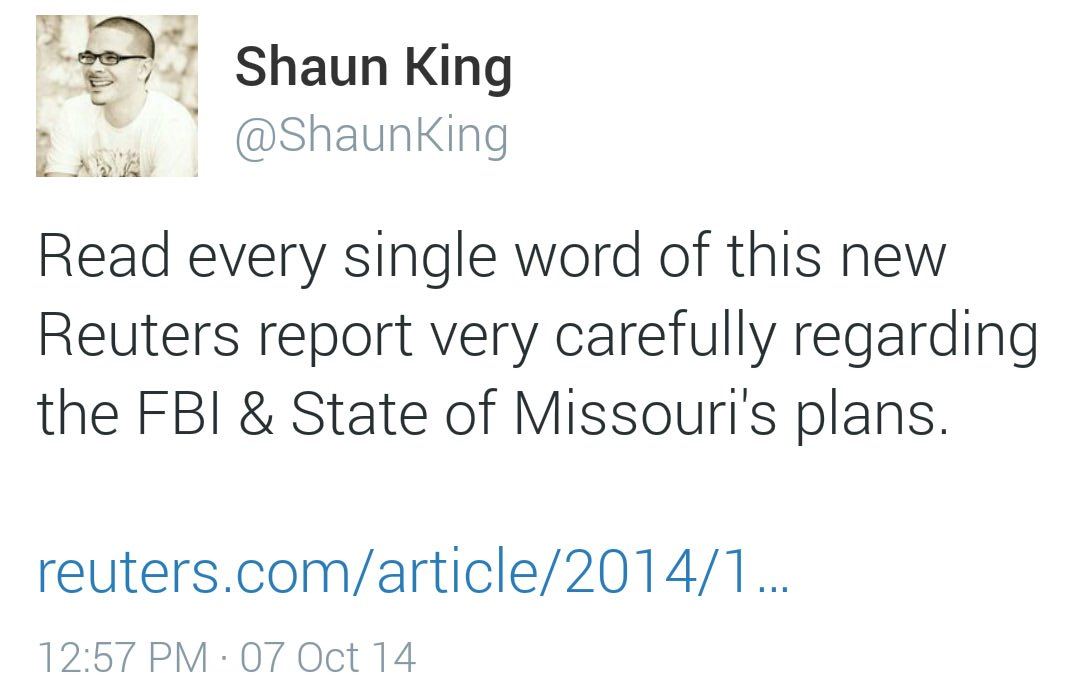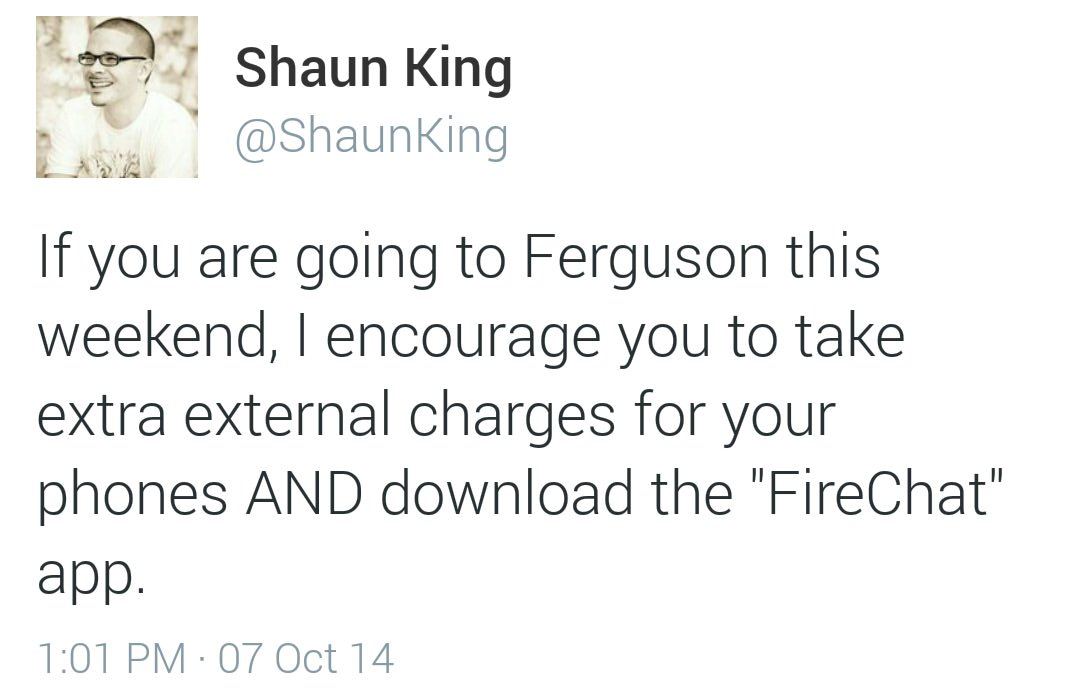WEEKEND EDITION OCTOBER 3-5, 2014
The Seeds of Bias in the Michael Brown Case
Who Killed Prosecutor Robert McCullough’s Father?by PETER JAMES HUDSON
More than 100,000 people have signed a petition demanding St. Louis County Prosecuting Attorney Robert McCulloch recuse himself from the grand jury investigating the killing of Michael Brown by white police officer Darren Wilson. McCulloch’s deep loyalties to the St. Louis Police Department, as evidenced by his prosecution of two racially charged, high-profile cases, have prompted critical doubts about his ability to fairly adjudicate evidence vindicating Brown, and implicating Wilson. His prosecution of a black man charged with murdering a St. Louis County police officer in 1991 raised serious questions about his motives, and in McCulloch’s 2001 investigation of the killing of two unarmed black men (whom McCulloch referred to as “bums”) by two white undercover police officers, questions arose, this time concerning McCulloch’s handling of witness testimony. The officers were never indicted.
McCulloch’s fealty to the police is clear. He has stated that he would have joined the force (after a stint in the military) had he not lost a leg to cancer as a teenager. “I couldn’t become a policeman,” he told the St. Louis Post-Dispatch, “so being county prosecutor is the next best thing.” If he had become a cop, he would have followed a well-worn family path. His brother Joseph was a sergeant in St. Louis’s Ninth District. For two decades his mother, Anne, was employed as a clerk in the homicide division. His father, Paul, joined the force in 1949 before resigning to serve with the US Marines in Korea. Paul McCulloch returned to the SLPD in 1951 and in 1955 became an original member of the department’s Canine Corps. He became a minor celebrity because of the work of Duke, described by the Chicago Defender as his “reefer-sniffing dog.”
Fifty years before Michael Brown was shot to death on the streets of Ferguson, McCulloch’s father died in the line of duty. The father’s death casts additional doubt on the son’s ability to lead the grand jury investigation into Brown’s killing, while at the same time shedding a garish light on the history of racism, policing, and the law in St. Louis.
Paul McCulloch was killed the evening of July 2, 1964, during a gun battle in St. Louis’s infamous Pruitt-Igoe housing projects. His alleged killer, Eddie Steve Glenn, was a black man who had reportedly abducted a white woman. McCulloch was 12 years old at the time of his father’s death. He still gets emotional when the incident is brought up, though he denies that the killing has influenced his vision as a prosecutor. “My father was killed many, many years ago, and it’s certainly not something you forget, but it’s certainly not something that clouds my judgment in looking at a case,” McCulloch told the St. Louis Post-Dispatch in 1991. “It certainly makes you more aware of the severity of it.”
Yet the memory of the killing clearly lives on. McCulloch evoked his father’s death in his campaign ads during his run for D.A. in 1991, and in the wake of the protests in Ferguson newspapers including The New York Times have recycled a redemption narrative of the bereaved son of an officer felled in the line of duty emerging as a messianic defender of justice. The killing of McCulloch’s father has also become part of the institutional lore of the St. Louis Police Department. Online bulletin boards and memorial pages contain posts written by police officers and their relatives offering condolences to the McCulloch family and providing testimony to Paul McCulloch’s character. McCulloch’s father is featured in the compilation In the Line of Duty: St. Louis Police Officers Who Made the Ultimate Sacrifice, written by St. Louis police librarian Barbara Miksicek. Published via a $7,500 donation from the St. Louis Police Foundation, the second edition of In the Line of Duty came out this past March. In July of this year, the Gendarme, the monthly newsletter of the St. Louis Fraternal Order of Police, published a story marking the 50-year anniversary of McCulloch’s death.
There is, however, a problem with this story of murder and memorialization. The problem is this: Eddie Glenn may not have murdered Robert McCulloch’s father.
While Glenn was charged and convicted of first-degree murder by the Missouri courts, a close reading of the state’s justifications for his conviction and sentence suggests two alternative possibilities. One, Glenn might have been guilty of second-degree murder or manslaughter, but should have been acquitted anyway due to the circumstantial and doubtful nature of the evidence against him. Two, McCulloch might have been killed by either his own gun or from gunfire from a fellow officer.
In either scenario, what is abundantly clear is that Glenn was railroaded to a murder conviction and a death sentence. During his arrest and trial there were egregious violations of his civil and constitutional rights by the St. Louis Police Department and the Missouri courts. There were questions concerning the circumstances under which Glenn’s confession was obtained. There were doubts surrounding the bias of the presiding judge and concerns with his prejudicial interventions into the defense’s cross-examination of police witnesses. Forensic evidence in the case was ambiguous. The jury — made up of 12 white men — was predisposed to find him guilty. And perhaps most importantly, there were no witnesses to the alleged crime.
Furthermore, as narrated by the St. Louis Police Department and the State of Missouri, the events leading to the killing of Paul McCulloch are so laden with anti-black stereotypes and so structured by white fears of African-American criminality that the entire incident appears almost as a caricature, an opéra bouffe, of 1960s white Southern justice — if only its denouement were not so tragic, and if only it did not undermine the possibilities of justice for Michael Brown.
*
What happened that day in St. Louis? According to the State of Missouri, on July 2, 1964, Eddie Steve Glenn, “a Negro,” had spent the afternoon drinking whiskey and had ingested two barbiturate “goofballs.” By the early evening, drunk and high and needing 16 dollars for a heroin fix, he decided to rob Marilyn Morris. Morris, a white woman, had double-parked her ’51 Chevrolet Impala in front of her father’s Food Fair Super Market on the 800 block of North Leffingwell. Glenn got into the passenger seat, brandished a knife, and told Morris to drive. Glenn took four dollars and some change from Morris’s purse, pulled the diamond ring from her finger, and the two of them drove for the next hour, stopping only once to get a dollar’s worth of gas.
Morris honked her horn repeatedly in an attempt to draw attention to her abduction, but no one came to her aid until St. Louis police officer Robert Steele, responding to a report on the police radio, spotted the Impala. Steele pulled it over on North 20th Street by DeSoto Park and approached the car from the driver’s side. He asked Morris her name. Morris told him, jumped from the car, and ran from the scene. Steele drew his .38 caliber Smith & Wesson and ordered Glenn out of the car. As Glenn got out, he lunged at Steele, grabbing for his gun. During the ensuing struggle, a single shot was fired. Glenn managed to wrestle away Steele’s weapon. Steele, covered in blood and thinking he had been shot — though, in fact, the bullet had hit Glenn — managed to radio for backup. Glenn then fired two shots at Steele, both shots missing their target, before sprinting across the baseball diamonds of DeSoto Park toward the Pruitt-Igoe housing development. He tried unsuccessfully to steal a ’59 Buick before entering the passageway between the project’s towers.
A minute after hearing Steele’s call, two more police officers, Ralph Atkins and Ronald Pott, arrived. Atkins took Steele to the hospital. Pott chased Glenn into Pruitt-Igoe. Paul McCulloch, just beginning his shift, joined Pott in pursuit. They tried to encircle Glenn, attempting to corner him between the project towers. But Pott suddenly found himself face to face with Glenn. Both men fired. Pott was shot in his left arm and fell to the ground; Glenn was wounded in the abdomen but managed to stay standing. By this time, more officers had arrived on the scene: James Miller, a member of the housing project’s police force, along with St. Louis police officers Dan Kirner and Arthur J. Mueller. As residents of Pruitt-Igoe scrambled for cover, a gunfight erupted. Glenn was shot several times before Mueller flattened him with a riot gun whose cartridges were packed with double-ought buckshot, metal balls a quarter-inch in diameter.
Glenn was in critical condition and remained so for the next two days. He suffered from multiple gunshot wounds. Bullets had punctured his colon and bladder. There were pellets in one of his fingers, and a bullet was lodged in his left foot. He was taken to St. Louis’s City Hospital #1, where he underwent surgery close to midnight.
McCulloch was found lying on the Pruitt-Igoe walkways, bleeding from a single gunshot wound to his head. He was pronounced dead on arrival at the hospital.
*
On July 16, 1964, the State of Missouri indicted Glenn for McCulloch’s murder. Two days later, the court appointed David M. Grant as Glenn’s attorney. Grant, a prominent St. Louis civil rights attorney, had studied at Howard University and was involved in one of the earliest desegregation campaigns in St. Louis. He was the head of the St. Louis chapter of the National Association for Colored People and was a local Democratic powerbroker. Grant met Glenn for the first time during his arraignment; Glenn was pushed into the courtroom, chained to his wheelchair, arms in casts, tubes draining his stomach. Glenn initially pleaded not guilty before changing his plea to not guilty by reason of mental disease or defect. When the case went to trial the following summer, Grant pressed for an acquittal.
Grant’s arguments were based on the conjectural quality of the evidence, the dubious and at times contradictory nature of testimony from prosecution witnesses, and the admissibility — and veracity — of Glenn’s confessions to the police. He pointed out to the jury that even though more than a thousand people lived in Pruitt-Igoe, and even though the incident occurred before dusk, there were no witnesses to McCulloch’s death. The events immediately surrounding McCulloch’s shooting were based largely on ambiguous and circumstantial evidence. The prosecution based its case on the testimony of Pruitt-Igoe resident Esaline King and patrolman Mueller, the officer who had shot Glenn with the riot gun. King claimed that she saw Glenn walking, heard the sound of a gunshot, and then turned around only to see McCulloch fall. While she did not see Glenn shoot McCulloch, she also could not consistently identify Glenn in court. Like King, Mueller did not see Glenn shoot McCulloch, but he stated that he found Glenn near the body of McCulloch, “acting like he was getting out of a scuffle with someone.” While the court conceded, “no one actually saw defendant point his gun at Officer McCulloch and shoot,” it saw both statements, from King and Mueller, as powerful implications of Glenn’s direct involvement in the killing.
The court also admitted that the forensic evidence was ambiguous: McCulloch could have been shot by Glenn, by his own gun, or by another officer. While Grant tried to draw this out through his cross-examination of ballistic experts, his efforts did not apparently convince the jury.
Glenn did not testify during the trial, but his confessions, allegedly made in the hospital in the hours and days following McCulloch’s killing, became an important part of the case against him. He was first interviewed as he lay on a gurney outside the operating room before he entered surgery. Though he was described as “incoherent” and complained that “his stomach was hurting and burning,” he allegedly told a circuit district attorney that he thought he was going to die and confessed to killing McCulloch. The next morning, though still in critical condition, additional St. Louis police officers interviewed him and Marilyn Morris was brought to the hospital to identify him. A few days later, days before a second surgery to remove the pellets from his hand, detectives interviewed him again.
Throughout the interviews, Glenn was in considerable pain. He was physically exhausted from the shooting, the surgery, and the sedation. He did not have a lawyer present during any of the interviews, and it was unclear whether or not his confessions were coerced. Under 24-hour police guard during his stay in the hospital, only the police and representatives of the district attorney’s office were in the room during the interviews. Visitation rights were only granted to his mother, and she was only permitted to come for 15 minutes at a time.
While some of Glenn’s confessions were not allowed in court, those that were were given to St. Louis police officers without other witnesses present. Glenn’s voice, such that it was, emerges through the courtroom testimony of the police. The following quotation, for instance, comes from Detective Keady’s courtroom testimony recounting his hospital-bed interview with Glenn days after the events in question:
I then asked [Glenn], “Can you recall just what happened night before last in regard to Marilyn Morris and the shooting of police officers?” And he said “I remember seeing the white girl parked in the car in the 800 block of North Leffingwell.” He said, “I got in on the right side and showed her my knife and told her to drive on.” He continued, he said, “I took four dollars from her purse, a dollar of which we bought gas with and I took — she gave me the ring from her finger.” I said, “Eddie, do you remember shooting the police officers?” And he said, “Yes, I remember the first police officer that pulled the car over to the curb, … I remember shooting him.” I said, “Well, you didn’t shoot that police officer, you shot at him, … you didn’t hit him; that was Robert Steele.” I said “Do you remember the other two police officers?” He said, “yes.” I said, “Do you remember shooting them?” He said “Yes. … I remember shooting the policeman who shot me in the side.” I said, “That would be Ronald Pott. Do you remember shooting Paul McCulloch, the other police officer?” He said, “I remember shooting a police officer and seeing him fall to the ground.” I said “Who did you shoot first, the police officer who shot you, who would be Pott, or McCulloch?” He said, “I don’t remember because I had been drinking a lot of liquor and I had taken those two goofballs.”
If the statements did in fact come from Glenn, it is surprising he would so willingly implicate himself without a measure of threat somewhat stronger than Keady’s obvious coaxing and prodding. However, when Grant tried to challenge the confessions based on both their constitutional validity and the fact that they were made (if they were made at all) under duress, the presiding judge dismissed his arguments and the court upheld the confessions as admissible and voluntary. When Grant attempted to show the contradictions in police testimony concerning the events on the evening of July 2, 1964, the judge shut down his inquiries. When Grant attempted to demonstrate that the police officers could have worked together to present a unified story before the trial, his questions were squelched and his theory squashed.
It is impossible to know where Grant’s questions may have led if he had been permitted to ask them. But it is entirely plausible that the St. Louis Police Department pinned McCulloch’s killing on Glenn to cover up and protect one of their own brothers. Additionally, a reading of both the trial transcript and the State of Missouri’s interpretation of the case also suggests that all is not as it appears in the circumstances leading to McCulloch’s killing. While Glenn admitted to entering Morris’s car, it seems implausible that a white woman could drive a black man around 1964 St. Louis for an hour, all the while honking the car horn, and stopping for gas, without attracting attention or arousing suspicion. It is bizarre that they could have driven an hour from North Leffingwell while ending up at DeSoto Park, less than five minutes away. It is hard to understand how Steele could not know that he had not been shot and could be thrown into a faint-like daze through his non-injuries. It is strange that a drink- and drug-addled man could wrestle a gun from a sober police officer before engaging in a running gun-battle with four or five police officers, killing a police officer with a clean shot with his last bullet. It is implausible that a black man would so easily confess to killing a white cop without a measure of strong-arming and threats. It is equally unlikely that the St. Louis police did not in some way script their story to ensure a conviction.
None of this mattered. On November 27, 1965, an all-white, all-male jury deliberated for an hour and 15 minutes before finding Glenn guilty of murder and recommending a sentence of death. Glenn was sentenced to die in Missouri’s gas chamber early in the next year.
His conviction was easy to come by. As Grant argued in court, in the weeks leading up to the trial, local newspapers had published editorials and articles sensationalizing violence against St. Louis police officers. They demanded tough, remorseless sentencing of those convicted of assaults on law enforcement. Incidents at Pruitt-Igoe (in one case involving Steele, the officer that had pulled over Glenn and Morris) were at the center of their concerns. Even before 1964, St. Louis had a well-known history of racial strife and racist terror. The deadliest incident of anti-black violence in 20th-century United States history occurred across the Mississippi River in East St. Louis during the 1917 riots, when whites marched on black neighborhoods, viciously attacking them and burning their homes. The death toll among African Americans was estimated at close to 200, while 6,000 were left homeless. In 1960, St. Louis police had rounded up hundreds of black men when a white woman alleged that a group of black men had abducted and raped her. While local newspapers inflamed the situation, when inconsistencies began to appear in her story, the woman later recanted and admitted that she had made it up. During this same period, both the NAACP and the Congress of Racial Equality had been involved in desegregation and anti-discrimination campaigns in the city, their efforts dramatized in CORE’s 1963 protests against the hiring practices of the Jefferson Bank. When 19 organizers — dubbed the Jefferson Bank Nineteen — were arrested by the St. Louis Police Department, the broader community was galvanized and joined the protests.
* * *
Born poor and black in Carbondale, Illinois, in 1927, Eddie Glenn had been sentenced from birth. His father was a railroad laborer and his mother a day worker. His parents separated when he was 11. He was kicked out of school early, told that he “could not learn.” He was sent to a vocational school but dropped out because he could not afford the uniforms. He went in and out of reform schools and juvenile correctional facilities while supporting himself by pickpocketing and gambling. By his mid-20s, his life became defined by the time he spent in the Missouri corrections system: from February 24, 1949, to May 27, 1950, he was jailed for second-degree burglary and grand larceny; from October 25, 1950, to January 23, 1956, he was jailed for first-degree robbery with a deadly weapon; from October 11, 1957, to March 17, 1964, he was jailed for first-degree robbery with a deadly weapon and carrying a concealed weapon.
When Glenn wandered up to Marilyn Morris’s Impala on July 2, 1964, he had been out of jail for less than six months. The encounter sent him back for the rest of his life.
On May 13, 1968, Grant appealed Glenn’s conviction. The state rejected the appeal out of hand and denied Glenn a new trial. He spent the next five years in an 8-by-10-foot cell in B-South, the punitive section of the Maximum Security Unit of the Missouri Penitentiary, alongside what were described as “the most incorrigible of prisoners segregated from the general prison population and prisoners who had become insane.” In the early 1970s, he was removed to the general prison population. His death sentence was reduced to life, and he died in prison in 1985.
Yet long before his death, Glenn’s life had taken on a meaning beyond him. As the black man who allegedly killed Officer McCulloch, he became a figure through which the St. Louis Police Department could project their fears and antipathies toward blacks. Glenn became a signifier for the vulnerability of the police, for their victimization; he became part of the web of stories, told and retold and passed down across generations that hardened the consanguineous loyalties of the St. Louis police and the righteous story of identity of St. Louis Prosecuting Attorney Robert McCulloch. Within the story of Eddie Glenn’s life and Paul McCulloch’s death is the seed of bias shaping Robert McCulloch’s decisions in the Michael Brown case. But that story is far from clear, and may be based, as so many similar stories have been, on a convenient set of lies.



